Scouting Report by Derek Bodner. Video Analysis by Mike Schmitz
Few players over the years have been as enigmatic as Purdue big man A.J. Hammons.
With excellent 7-foot size, a strong frame, shot blocking instincts that made him a defensive force, touch around the basket, and a mid-range jump shot that always seemed to be on the verge of becoming realized, the soon to be 24-year old Hammons has been on the radar as a prospect ready to break out for quite some time.
Yet there always seemed to be something missing, something which prevented Hammons' impact from being quite as high as the sum of his parts. Whether it was his inconsistency on the defensive glass, his inability to turn that jump shot into a regular part of his offensive game, his irregular motor and lack of focus on and off the court, Hammons has never quite had the impact you expected him to.
Hammons took significant steps in that regard this season, as he was a more consistent, and well-rounded contributor for the Boilermakers in his final season at Purdue, helping head coach Matt Painter to a 26-win season, his best since the 2010-11 squad led by JaJuan Johnson and E'Twaun Moore. His season ended on somewhat of a disappointing note, though, with a first round NCAA Tournament loss to #12 seed Arkansas-Little Rock.
Hammons' intrigue as a prospect begins with his proficiency as a shot blocker. Hammons averaged 4.1 blocks per 40 minutes, pace adjusted, the third best mark in our top-100 ranking. Hammons uses his 7'3 wingspan, good mobility, excellent instincts, and a surprisingly quick second jump for a player of his size to alter shots at the rim, and was the key component in transforming Purdue into a top-20 defensive team.
Hammons' size and strength also allow him to be an effective post defender, as he's strong enough to hold his ground in the paint and uses his length to alter shots around the rim. He can still do a better job of denying position early, something he's mostly been able to overcome against the competition he's faced at the collegiate level, but which he'll have to do a better job of against some of the post-scoring talent he'll face in the NBA, which starts with showing a higher intensity level early in possessions.
Where Hammons has really improved has been on the defensive glass, as his 13.4 defensive rebounds per 40 minutes, pace adjusted, and 24.8% defensive rebounding rate are both easily career highs. Between Hammons and Caleb Swanigan, Purdue was one of the best defensive rebounding teams in the nation, and Hammons being more focused in this phase of the game helps his projection as a role player at the next level quite a bit.
Offensively, Hammons' bread and butter remains in the post, where over 60% of his offensive possessions come from, according to Synergy Sports Technology. Hammons shot 58.5% on shots out of post-up situations and averaged 1.217 points per possession according to Synergy, being one of the most efficient high-usage big men in the nation in that regard.
Hammons has excellent touch around the rim and uses his size, and length, well around the hoop. Hammons' footwork still isn't the most diverse or fluid, but he has a solid drop step, a fairly reliable jump hook, and has showcased an emerging turnaround jump shot, something that he can, at times, settle for with a little more frequency than you'd like. He did a better job of establishing good position in the post this year and seals his man off well, although he can still occasionally be pushed out further than you'd like, and be forced into more difficult shots than he would if he fought for position early.
Hammons' biggest weakness in the post remains his passing, although he did cut down on his turnovers some, as Synergy logged turnovers on just 12.7% of his post-up possessions, down pretty significantly from the 16.7% he averaged during his junior year. Still, averaging 3.4 turnovers per 40 minutes, pace adjusted, compared to just 1.8 assists, Hammons doesn't use the attention he receives in the post to create scoring opportunities for his teammates with any kind of regularity.
That jump shot, which we noted last year was showing potential, has become more realized into an actual weapon this season. Synergy logged 43 jump shots for Hammons beyond 17 feet, of which he shot 48.8% on, a pretty sizable improvement over the 16% on 25 field goal attempts he shot during his junior season. The sample size is very small, but the improvement, combined with what appears to be more consistent form and an increased comfort level, provides some hope for the future.
While Hammons can still go through periods where he seems to float, particularly offensively, he's improved in that area fairly significantly this season. He's developed, at least a little bit, as a jump shooter, while his impact on the defensive glass has improved substantially, and he's made his presence felt more consistently in the paint offensively. When you combine that with his excellent size and shot blocking instincts, it's increasingly likely that Hammons can carve out a niche as a role player at the next level, provided he proves willing of playing hard on a consistent basis, and is able to avoid many of the off-court issues that plagued him through his four years at Purdue. The fact that he turns 24 in August will likely prevent him being a top-20 pick, but a team could see real value in his ability to contribute right away in the 20-40 range, provided they aren't scared off by his red flags.
More DX Scouting Reports and Video Breakdowns:
-Oregon State's Gary Payton II
-Washington's Marquese Chriss
-Kansas' Cheick Diallo
-Washington's Dejounte Murray
-Baylor's Taurean Prince
-Michigan State's Denzel Valentine
-UNLV's Stephen Zimmerman
-Marquette's Henry Ellenson
-LSU's Ben Simmons
-Michigan's Caris LeVert
-Louisville's Damion Lee
-Florida State's Malik Beasley
-Florida's Dorian Finney-Smith
-Cibona's Ante Zizic
-Estudiantes' Juan Hernangomez
-Oakland's Kay Felder
Articles
Top NBA Prospects in the Big 10, Part Eight: #8-10
Oct 26, 2015, 01:11 pm
Jacob Eisenberg
A.J. Hammons arrived at Purdue with high expectations as a top-100 recruit. Three years later, he still hasn't quite established himself as a surefire NBA prospect. Now, already 23 years old, he's returning for his senior season in an attempt to build off of an impressive second half to the 2014-2015 campaign and improve his draft stock.
Hammons clearly has the size and strength the play in the NBA. At 7'0 and 280 pounds, there are few players in the nation who can match Hammons' brute physique. He uses his size to his advantage effectively on the interior. Last season, Hammons averaged 19.6 points and 10.9 rebounds per-40 minutes, both rating in the top-10 in DX's database among top-100 prospects.
Hammons is not only massive, but he's also long. He was measured with a 7'3 wingspan in 2011 so it's fair to assume he may be even longer now. He's earned his reputation as an elite rim protector at the college level; last season, Hammons averaged 4.6 blocks per-40 minutes a top-three rate in the NCAA among qualified prospects.
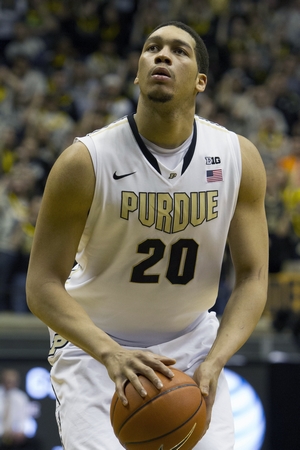
Offensively, Hammons can be overwhelming for opponents in the paint. More than half of his offensive possessions last season came with his back to the basket, where he made 93-of-180 of his post-ups (51.7%). When he wasn't posting up, Hammons lurked around the basket gained his team extra possessions on the glass. Hammons pulled down 4.0 offensive rebounds per-40 minutes and grabbed 12.2% of all available offensive rebounds as junior both rating in the top-10 for draft prospects. He also made 47-of-71 (66.2%) shots around the basket, proving he's capable of finishing consistently when establishing position around the paint.
Hammons will help himself greatly if he learns to battle more in gaining positioning near the rim. More often than not, he settles on the edge of the paint and starts his entry moves from shallow post positioning. Equipped with an effective drop step, Hammons should use his size to gain deep positioning before calling for entry passes. Unfortunately, he doesn't always display the type of intensity-level you'd like to see, as he often looks lethargic getting up and down the court and doesn't always display the type of toughness you'd like to see from a player with his physical attributes.
Hammons gets to the line frequently. He averaged 6.6 free throw attempts per-40 but while he's steadily improved his touch at the line, he's still just a 68.4% free throw shooter.
He has a surprisingly nice arc on his shots away from the hoop but has yet to translate the smooth mechanics into smooth efficiency. He made just four of his 25 jump shots attempts (16%) beyond 17 feet last season and often attempted those shots with his feet either on or within the three-point line showing a disregard for court awareness.
He's not comfortable nor willing as a passer, as evidenced by his pedestrian 1.5 assists per-40 minutes and lackluster 9.1% assist rate. This could be explained by the fact that bad things tend to happen when Hammons tries to create anything for teammates offensively. He's one of the most turnover prone players in the NCAA. Last season, he averaged 3.5 turnovers per-40 minutes the highest rate for all big men in the NCAA. And per Synergy Sports Technology, Hammons turned the ball over on a whopping 17.2% of his possessions last season a rate that simply won't cut it at the NBA level.
The root of Hammons' turnovers comes from his rigid footwork, which often leads to traveling violations. From December 8th to January 21st, Hammons was demoted to the bench, before a recalibration of focus brought him back to the starter's role.
While his movements are often mechanical, he actually does have decent mobility for a player of his size. He's not explosive but he gets off the ground for dunks with surprising quickness and finishes strong when he has momentum.
His mobility could eventually develop into a strong suit as a diver in pick-and-rolls at the next level. He has enormous hands and, with his wingspan, he should be an excellent lob target for his guards on alley oops.
Hammons' inconsistent motor is a major red flag in his game. He was held under 10 points in about a third of his team's games last season and finished with five or less total rebounds in about a quarter of his team's games. He's lowered his foul rate to a passable 4.2 fouls per-40 minutes but still commits unnecessary fouls early in the game which forces him to sit out on the action with consistency.
Overall, at 23 years old, what you see is likely what you'll get with Hammons at the next level. He's a physical specimen with the mobility and skill-level to develop into a solid rotation player in the NBA. Still, as a big man, he is a mediocre rebounder and is far too sporadic with his effort-level, not displaying anywhere near the type of intensity you'd like to see on a consistent basis. Still, with his size, length, skill-level, and rim-protection prowess, he's someone who will be getting looks for many years to come due to the scarcity of players at his position with similar attributes.
A.J. Hammons arrived at Purdue with high expectations as a top-100 recruit. Three years later, he still hasn't quite established himself as a surefire NBA prospect. Now, already 23 years old, he's returning for his senior season in an attempt to build off of an impressive second half to the 2014-2015 campaign and improve his draft stock.
Hammons clearly has the size and strength the play in the NBA. At 7'0 and 280 pounds, there are few players in the nation who can match Hammons' brute physique. He uses his size to his advantage effectively on the interior. Last season, Hammons averaged 19.6 points and 10.9 rebounds per-40 minutes, both rating in the top-10 in DX's database among top-100 prospects.
Hammons is not only massive, but he's also long. He was measured with a 7'3 wingspan in 2011 so it's fair to assume he may be even longer now. He's earned his reputation as an elite rim protector at the college level; last season, Hammons averaged 4.6 blocks per-40 minutes a top-three rate in the NCAA among qualified prospects.

Offensively, Hammons can be overwhelming for opponents in the paint. More than half of his offensive possessions last season came with his back to the basket, where he made 93-of-180 of his post-ups (51.7%). When he wasn't posting up, Hammons lurked around the basket gained his team extra possessions on the glass. Hammons pulled down 4.0 offensive rebounds per-40 minutes and grabbed 12.2% of all available offensive rebounds as junior both rating in the top-10 for draft prospects. He also made 47-of-71 (66.2%) shots around the basket, proving he's capable of finishing consistently when establishing position around the paint.
Hammons will help himself greatly if he learns to battle more in gaining positioning near the rim. More often than not, he settles on the edge of the paint and starts his entry moves from shallow post positioning. Equipped with an effective drop step, Hammons should use his size to gain deep positioning before calling for entry passes. Unfortunately, he doesn't always display the type of intensity-level you'd like to see, as he often looks lethargic getting up and down the court and doesn't always display the type of toughness you'd like to see from a player with his physical attributes.
Hammons gets to the line frequently. He averaged 6.6 free throw attempts per-40 but while he's steadily improved his touch at the line, he's still just a 68.4% free throw shooter.
He has a surprisingly nice arc on his shots away from the hoop but has yet to translate the smooth mechanics into smooth efficiency. He made just four of his 25 jump shots attempts (16%) beyond 17 feet last season and often attempted those shots with his feet either on or within the three-point line showing a disregard for court awareness.
He's not comfortable nor willing as a passer, as evidenced by his pedestrian 1.5 assists per-40 minutes and lackluster 9.1% assist rate. This could be explained by the fact that bad things tend to happen when Hammons tries to create anything for teammates offensively. He's one of the most turnover prone players in the NCAA. Last season, he averaged 3.5 turnovers per-40 minutes the highest rate for all big men in the NCAA. And per Synergy Sports Technology, Hammons turned the ball over on a whopping 17.2% of his possessions last season a rate that simply won't cut it at the NBA level.
The root of Hammons' turnovers comes from his rigid footwork, which often leads to traveling violations. From December 8th to January 21st, Hammons was demoted to the bench, before a recalibration of focus brought him back to the starter's role.
While his movements are often mechanical, he actually does have decent mobility for a player of his size. He's not explosive but he gets off the ground for dunks with surprising quickness and finishes strong when he has momentum.
His mobility could eventually develop into a strong suit as a diver in pick-and-rolls at the next level. He has enormous hands and, with his wingspan, he should be an excellent lob target for his guards on alley oops.
Hammons' inconsistent motor is a major red flag in his game. He was held under 10 points in about a third of his team's games last season and finished with five or less total rebounds in about a quarter of his team's games. He's lowered his foul rate to a passable 4.2 fouls per-40 minutes but still commits unnecessary fouls early in the game which forces him to sit out on the action with consistency.
Overall, at 23 years old, what you see is likely what you'll get with Hammons at the next level. He's a physical specimen with the mobility and skill-level to develop into a solid rotation player in the NBA. Still, as a big man, he is a mediocre rebounder and is far too sporadic with his effort-level, not displaying anywhere near the type of intensity you'd like to see on a consistent basis. Still, with his size, length, skill-level, and rim-protection prowess, he's someone who will be getting looks for many years to come due to the scarcity of players at his position with similar attributes.
NBA Draft Prospect of the Week: A.J. Hammons
Mar 04, 2014, 03:59 pm
A.J. Hammons is a rare breed of college basketball player, a long-armed 7-footer with a massive frame, solid mobility and a back to the basket game. Barring a Big Ten conference tournament miracle, his Purdue team will miss the NCAA Tournament for the second straight season, after making the Dance the previous six years before he arrived on campus.
-NBA Draft Prospect of the Week: K.J. McDaniels (Video Scouting Report)
-NBA Draft Prospect of the Week: Deonte Burton (Video Scouting Report)
-NBA Draft Prospect of the Week: Noah Vonleh (Video Scouting Report)
-NBA Draft Prospect of the Week: Nik Stauskas (Video Scouting Report)
-NBA Draft Prospect of the Week: Aaron Gordon (Video Scouting Report)
-NBA Draft Prospect of the Week: Clint Capela (Video Scouting Report)
-NBA Draft Prospect of the Week: Thanasis Antetokounmpo (Video Scouting Report)
-NBA Draft Prospect of the Week: Shabazz Napier (Video Scouting Report)
-NBA Draft Prospect of the Week: Bogdan Bogdanovic (Video Scouting Report)
-NBA Draft Prospect of the Week: Joel Embiid (Video Scouting Report)
-NBA Draft Prospect of the Week: Julius Randle (Video Scouting Report)
-NBA Draft Prospect of the Week: Jabari Parker (Video Scouting Report)
-Revisiting Giannis Antetokounmpo (Video Scouting Report)
-Revisiting Damian Lillard (Video Scouting Report)
-Revisiting Nikola Mirotic (Video Scouting Report)
-Revisiting Alexis Ajinca (Video Scouting Report)
Hammons is a real inside presence on both ends of the floor, seeing a significant portion of his offense inside the paint and also being quite an intimidating presence defensively. He has the strength needed to establish deep post-position, reliable hands, and is capable of getting off the floor effectively to finish emphatically around the rim, even through contact.
Not particularly skilled or polished, Hammons relies on his size and strength to get the job done at the college level. His footwork isn't particularly advanced, as he only makes a lackluster 52% of his 2-point attempts, but he gets to the free throw line at an excellent rate, and converts 70% of his attempts once there.
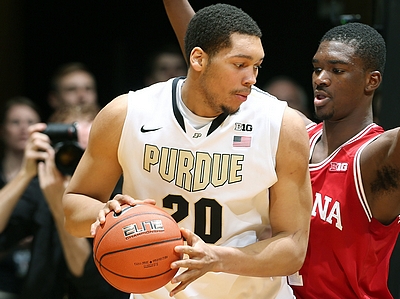
A mediocre passer at best, Hammons generates one assist for every 41 minutes he's on the court, ranking last among Top-100 prospects in PPR, assist to turnover ratio, assists per possession, and basically every other passing metric. His shot-selection and decision making is extremely poor at times, which is partially due to the quality of his teammates, as he has very few Big Ten quality options alongside him.
Hammons is somewhat of a mixed bag defensively. On one hand he ranks as one of the top shot-blockers in all of college basketball, rejecting 5 shots per-40 minutes, as his long arms, solid mobility and excellent timing make him quite a presence as a rim protector. On the other hand, his fundamentals on this end of the floor are overall quite poor, as he can be extremely lazy in the way he approaches his work here, rarely getting in an actual stance, doing a poor job of contesting shots, and letting opponents blow right by him without any resistance. He's somewhat of a liability in the pick and roll, and is fairly foul prone, which is one of the reasons he only plays 24 minutes per game for a Purdue team that lacks great frontcourt depth.
As a rebounder, Hammons shows potential, as his big frame, long arms, soft hands and solid mobility can make him quite a presence when he's really dialed in. He's averaging over 12 rebounds per-40 minutes, a solid mark, but would almost certainly be considered elite at the college basketball level if he played with the same intensity and did a better job of boxing out opponents consistently.
Hammons is reportedly highly likely to put his name in the 2014 NBA Draft, which makes sense considering he is the same age as many collegiate seniors, as he turns 22 this August. His excellent size, long arms, strong frame, shot-blocking prowess, rebounding potential and budding offensive game give him a very good chance to get drafted, especially considering how few true centers there are these days.
Matchups against the likes of Wisconsin, Iowa, Michigan, Ohio State, Michigan State, Oklahoma State and others have given us ample opportunity to evaluate Hammons' strengths and weaknesses as a prospect, which we've done in the following video scouting report, courtesy of Mike Schmitz.
All of our video scouting reports this season can be found here.
-NBA Draft Prospect of the Week: K.J. McDaniels (Video Scouting Report)
-NBA Draft Prospect of the Week: Deonte Burton (Video Scouting Report)
-NBA Draft Prospect of the Week: Noah Vonleh (Video Scouting Report)
-NBA Draft Prospect of the Week: Nik Stauskas (Video Scouting Report)
-NBA Draft Prospect of the Week: Aaron Gordon (Video Scouting Report)
-NBA Draft Prospect of the Week: Clint Capela (Video Scouting Report)
-NBA Draft Prospect of the Week: Thanasis Antetokounmpo (Video Scouting Report)
-NBA Draft Prospect of the Week: Shabazz Napier (Video Scouting Report)
-NBA Draft Prospect of the Week: Bogdan Bogdanovic (Video Scouting Report)
-NBA Draft Prospect of the Week: Joel Embiid (Video Scouting Report)
-NBA Draft Prospect of the Week: Julius Randle (Video Scouting Report)
-NBA Draft Prospect of the Week: Jabari Parker (Video Scouting Report)
-Revisiting Giannis Antetokounmpo (Video Scouting Report)
-Revisiting Damian Lillard (Video Scouting Report)
-Revisiting Nikola Mirotic (Video Scouting Report)
-Revisiting Alexis Ajinca (Video Scouting Report)
Hammons is a real inside presence on both ends of the floor, seeing a significant portion of his offense inside the paint and also being quite an intimidating presence defensively. He has the strength needed to establish deep post-position, reliable hands, and is capable of getting off the floor effectively to finish emphatically around the rim, even through contact.
Not particularly skilled or polished, Hammons relies on his size and strength to get the job done at the college level. His footwork isn't particularly advanced, as he only makes a lackluster 52% of his 2-point attempts, but he gets to the free throw line at an excellent rate, and converts 70% of his attempts once there.

A mediocre passer at best, Hammons generates one assist for every 41 minutes he's on the court, ranking last among Top-100 prospects in PPR, assist to turnover ratio, assists per possession, and basically every other passing metric. His shot-selection and decision making is extremely poor at times, which is partially due to the quality of his teammates, as he has very few Big Ten quality options alongside him.
Hammons is somewhat of a mixed bag defensively. On one hand he ranks as one of the top shot-blockers in all of college basketball, rejecting 5 shots per-40 minutes, as his long arms, solid mobility and excellent timing make him quite a presence as a rim protector. On the other hand, his fundamentals on this end of the floor are overall quite poor, as he can be extremely lazy in the way he approaches his work here, rarely getting in an actual stance, doing a poor job of contesting shots, and letting opponents blow right by him without any resistance. He's somewhat of a liability in the pick and roll, and is fairly foul prone, which is one of the reasons he only plays 24 minutes per game for a Purdue team that lacks great frontcourt depth.
As a rebounder, Hammons shows potential, as his big frame, long arms, soft hands and solid mobility can make him quite a presence when he's really dialed in. He's averaging over 12 rebounds per-40 minutes, a solid mark, but would almost certainly be considered elite at the college basketball level if he played with the same intensity and did a better job of boxing out opponents consistently.
Hammons is reportedly highly likely to put his name in the 2014 NBA Draft, which makes sense considering he is the same age as many collegiate seniors, as he turns 22 this August. His excellent size, long arms, strong frame, shot-blocking prowess, rebounding potential and budding offensive game give him a very good chance to get drafted, especially considering how few true centers there are these days.
Matchups against the likes of Wisconsin, Iowa, Michigan, Ohio State, Michigan State, Oklahoma State and others have given us ample opportunity to evaluate Hammons' strengths and weaknesses as a prospect, which we've done in the following video scouting report, courtesy of Mike Schmitz.
All of our video scouting reports this season can be found here.
Top NBA Draft Prospects in the Big Ten, Part 7 (#11-15)
Sep 23, 2013, 10:58 am
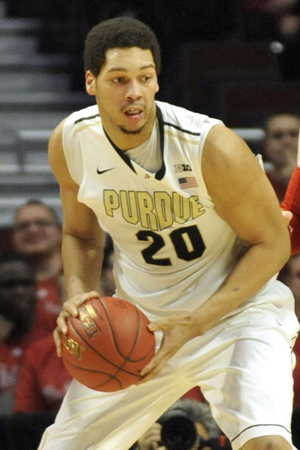
Jonathan Givony
Somewhat of an afterthought in the 2012 high school recruiting class, A.J. Hammons had a solid freshman season for Purdue, pumping in 18.2 points per-40 minutes to go along with 10.3 rebounds and 3.4 blocks, more than holding his own in the tough Big Ten conference despite his lack of experience. He was named to the Big Ten's all-freshman team alongside a host of highly touted prospects, and in the process established himself as a player to keep an eye on moving into his sophomore year.
Hammons' biggest assets as a NBA prospect revolve around his rare physical attributes. He possesses terrific size at 7-0 to go along with a very strong 278 pound frame, which he's reportedly cut down to 251 pounds after a productive summer, and has an excellent 7-3 wingspan to go along with that. He's also very mobile for his size, running the floor relatively well considering his girth and showing the ability to get off the floor nicely inside the paint. All told, Hammons is a gifted prospect from a physical standpoint, particularly if he's in optimal shape, which he reportedly is now.
As you'd expect, the overwhelming majority of Hammons' offensive touches came with his back to the basket, where he was just average in terms of scoring efficiency as a freshman, making 41% of his field goal attempts. He can establish deep post position when he wants to and is capable of making quick spin-moves to either shoulder to score with decent touch. He got to the free throw line a good amount, and made a solid 68% of his attempts once there. He shows nice potential as a back to the basket scorer, even if his skill-level, while certainly above average relative to his experience level, is still very much a work in progress.
Hammons doesn't always work as hard as you might hope to establish deep post-position and settles for a fair amount of low-percentage shots inside the paint. He still has plenty of room to improve upon his footwork and the range on his jump-hook and turnaround jumper, even if there's a lot to work with here.
Where Hammons was quite a bit more effective last season was as a finisher around the basket in non-post up attempts (cuts, pick and roll finishes, offensive rebounds, etc), making 68% of his looks in these situations. He has excellent hands, nimble feet, good body control and can finish with power and authority off two feet.
Unfortunately, he didn't see very many attempts of this nature as Purdue suffered from poor spacing, a lack of outside shooting and an inability to create high percentage shots out of pick and roll and one on one situations, which made their half-court offense very stagnant in the incredibly competitive Big Ten. Returning almost the entire roster from last season should help somewhat in that regard this upcoming year.
From the perimeter, Hammons shows some potential as a mid-range shooter, knocking down a handful of jumpers to go along with the above average percentage he shot from the free throw line. With that said, he wasn't consistent in this area by any means, partially due to poor shot-selection, as he was baited into some very long 2-point attempts that opposing defenses certainly didn't mind conceding. All in all, he made just 5 of the 23 mid-range jumpers he attempted last season, showing that he still has a long ways to go in this area.
Defensively is where many of the biggest concerns surrounding Hammons' NBA potential exist. He lacks intensity here in a major way, showing poor focus and awareness and often being very late to react to things going on the floor. He seems to be stuck playing at half speed on most possessions, willingly giving up deep post position and putting forth a very lackadaisical effort fighting back against opposing big men leaning on him. Like many big men his size, he struggles stepping outside the paint, but his problems are only exacerbated by how lazily he often approaches his work here.
His defensive rebounding leaves something to be desired as well for many of the same reasons, as he doesn't put great effort into boxing out his man and pursuing loose balls, despite having the physical tools to be incredibly effective in this area if he wanted to be.
With that said, Hammons has the length and timing to make up for some of his mistakes defensively, showing that he can be at least an above-average presence on this end of the floor if he ever committed himself to it. He rotates from the weak-side and challenges shots on the ball in impressive fashion at times, blocking 3.4 shots per-40 minutes last season, tied for third best amongst returning prospects in our top-100 rankings. He's difficult to shoot over with his towering height and long wingspan, coming up with a handful of very noteworthy possessions last season contesting shots on the interior and exterior that hint at good things to come if he's ever truly dialed in.
Hammons has been saying all of the right things this offseason about maturing and playing with better passion and consistency. Still, it's sensible to approach these types of remarks with a reasonable degree of skepticism. Questions about his work ethic and intensity have plagued him since his early days in high school, and these type of motivational issues don't tend to disappear in the NBA. If anything, they usually become more noticeable without the hand-holding and constant prodding players enjoy in college as the focal point of mid-level programs.
It will be interesting to see how much improvement Hammons makes between his freshman and sophomore year, as besides the question marks about his love of the game, he's also a year older than most of the players in his class as a 21 year-old sophomore. Hammons' ability to take the next step in his development should give us a clearer picture about the extent of his upside. After missing the NCAA Tournament for the first time in seven years last season, Matt Painter and Purdue will be eager to get back on the right track, and Hammons will certainly play a big role in that.
HoopHall Classic Scouting Reports: 2012 Prospects (Part Three)
Jan 23, 2012, 05:24 pm
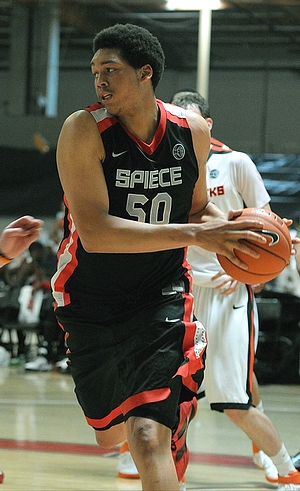
Joe Treutlein
A.J. Hammons (#83 Scout, #123 Rivals, #78 ESPN) had a solid showing in Oak Hill's blowout win over Prestonwood, scoring 6 points to go along with 8 rebounds and 3 blocks.
A legit 7'0 center with a solid 7'3 wingspan, Hammons has good mobility for his size, along with a developing feel for the game. He has a strong frame already holding a lot of weight, and probably isn't at his athletic peak, as he lacks much in muscle definition and could benefit from a college strength program.
In terms of his skills, Hammons is fairly raw at this stage, operating mostly with simple post moves and finishes around the basket. He shows good hands and touch around the basket along with a willingness to finish with power when necessary, though he tends to go through stretches of disappearing from the game at times, not willing to assert himself consistently. Hammons' conditioning also doesn't appear to be as good as it could be, and it affects his ability to get up and down the floor consistently and stay involved for long stretches.
On the defensive end, Hammons had a nice showing in his game here, showing a good activity level with three blocked shots, including some he did a good job rotating over from the weak side. He showed decent timing on his blocks and did a similarly good job staying in front of his man on post defense, looking solid with his defensive abilities for his age. Just as on the offensive end, however, getting into peak shape and staying consistently focused every play will be critical for Hammons going forward.














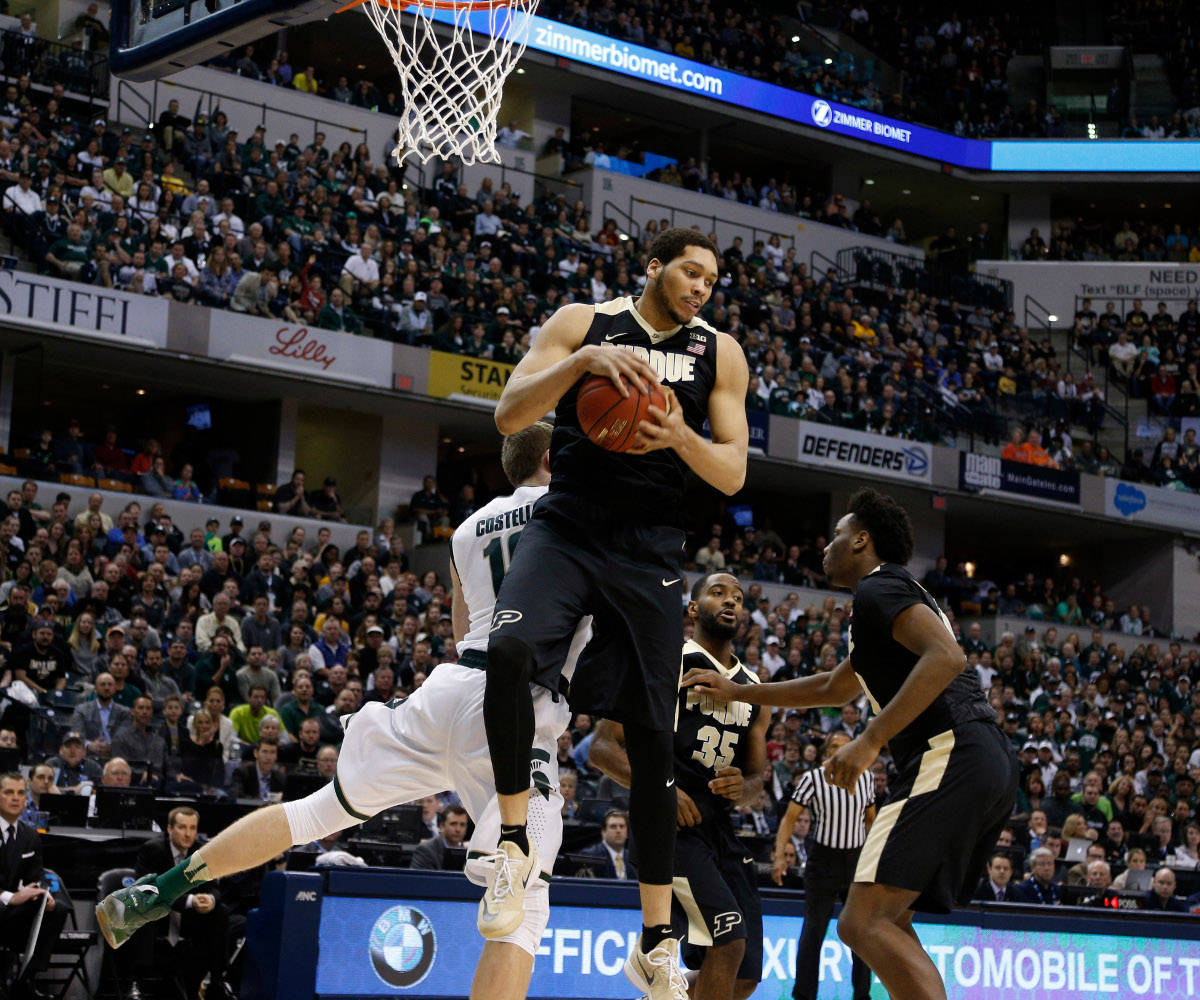














Comments